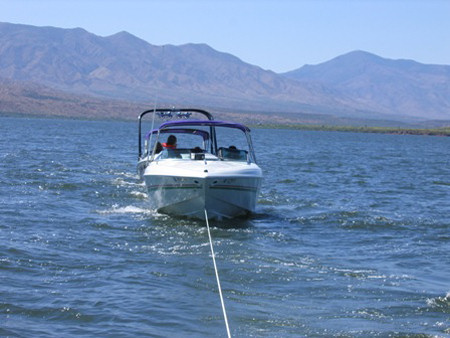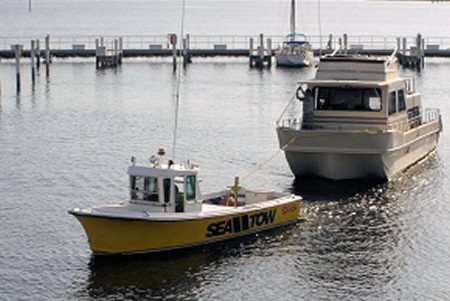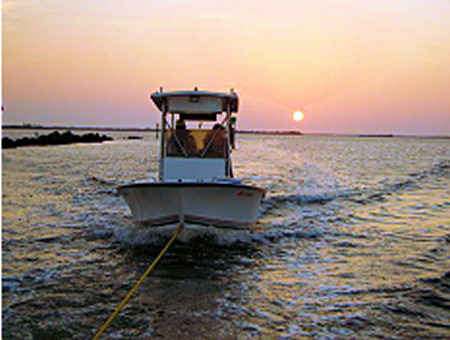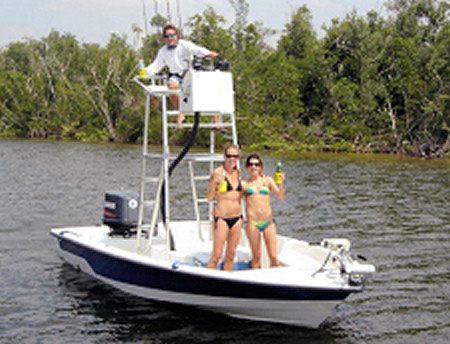To Tow, or, Not to Tow
It’s a rare occurrence that one boater would see another in a jam offshore and not stop to help. But in some instances, the help you render could be the wrong kind. Let’s take the subject of towing, for example. Most recreational powerboats are not designed to be tow boats, nor have their owners, in most cases, been educated on safe towing procedures. Towing another boat is fraught with risks, including the potential for serious injury, damage to the boat needing help or to tow boat, to say nothing of the possibility of resulting litigation. Yet, it is your obligation to help a fellow boater in distress. What to do? Here is our recommendation about how to do your duty and stay out of trouble at the same time.
 There are actually two boats being towed here which could mean twice the trouble. What is a good skipper to do? |
Generally speaking, recreational boats are ill-equipped to safely handle the problems of other boaters in need on the water. Further, some insurance policies have negative consequences for doing so.
 Towing is not easy work, that is why it takes special equipment and knowledgeable operators. |
The reasons for those policy exclusions are because of the many potential dangers inherent in towing. Tie a tow line to a stern cleat and it is likely to pull out the cleat, or if towing from a single quarter, to sink the tow boat. You could set up a bridle to tow from a centerline, however, depending on the size of the tow, it’s possible to pull two cleats out instead of one. Then there is the danger of the sling-shot effect of cleat pulling out under stress and hitting someone, or a tow line parting and becoming a whip.
If a vessel is aground and you try to tow the boat off, you could easily tear its running gear out, creating a hole in the bottom of the distressed boat. In that case you might have turned a boat that was merely aground into a boat that is sinking. Now you have real trouble on your hands, and much more than you bargained for as a good Sam.
Recommendation
The best and safest way to render towing assistance is to go over to the stricken vessel and ensure that everyone aboard is safe, unhurt and wearing life jackets. Lend them yours, if necessary. Ask if they have called the Coast Guard or a professional towing service.
If there are no life-threatening circumstances involved, then the Coast Guard will probably suggest that the distressed party call a towing service. Once the distressed party has called a towing service (they monitor channel 16), find out when they plan to arrive on the scene. Then tell the occupants of the distressed boat that you will stand by until the rescue vessel arrives.
 Note the post on in the cockpit of the Sea Tow boat where the towing line is connected. |
The fact that another boat and other people are just a few yards away keeping an eye on things will lend comfort, a sense of security and calm the party in distress. Also, you can maintain back-up communication with the responders. Now you are being a good Sam and at the same time you are protecting yourself and your own family or guests.
The Right Stuff
Sea Tow’s Chief Operating Officer, Capt. Joseph Frohnhoefer III, warns that often amateurs use an anchor line for towing but it usually is not adequate for the rigors at hand because of its stretch and breaking strength. Capt. Joe says, “Sea Tow’s towline is typically fabricated from a blend of synthetics that allow for up to a 10 percent stretch. Towlines also have a high breaking strength – usually a minimum of 10,000 lbs., for inshore work, and 50,000 lbs., for offshore work.”
 Almost home by sundown thanks to Sea Tow. |
Professional towers like Sea Tow also utilize safety gear like flashing lights to warn others that a boat is in tow, which can be essential on busy waters or when day fades to night. Sea Tow boats are fitted with dedicated tow points that are mounted toward the center of the boat, which greatly improves a captain’s ability to safely control both vessels. Beyond that, Frohnhoefer points out that Sea Tow boats are stocked with emergency fuel supplies and jump packs that can be used to correct problems on the water, thus avoiding the need for a tow all together. They’re all items that the vast majority of recreational boaters just don’t carry – especially not for other boaters.
Average Insurance Claim
Beyond all the technical aspects of towing, Allstate Insurance reports that boats damaged during Good Sam tows incur a minimum of $550 in damage, on average. Additionally, insurance carriers may void the policies of Good Sam towers who damage their (or the disabled) boat or cause harm by engaging in risky endeavors, which a tow is considered to be. Get out your policy and check, or call your insurance agent.
 Break out the greenies, the rescue boat has arrived. |
Win-Win
Capt. Joe says that calling Sea Tow to the scene has the potential to save everyone a lot of time. Because Sea Tow has so many locations and because the Sea Tow stations typically have a boat on the water and back-up boats available, assistance is often just minutes away. Once a Sea Tow vessel is on the scene you are immediately relived of your standby duties and can be on your way.
Chances are the tow will take a couple of hours because it must be slow and painstakingly careful. But in the meantime you will be completing the plans you had for your day, and happy in the knowledge that you helped a fellow boater and did not endanger yourself.